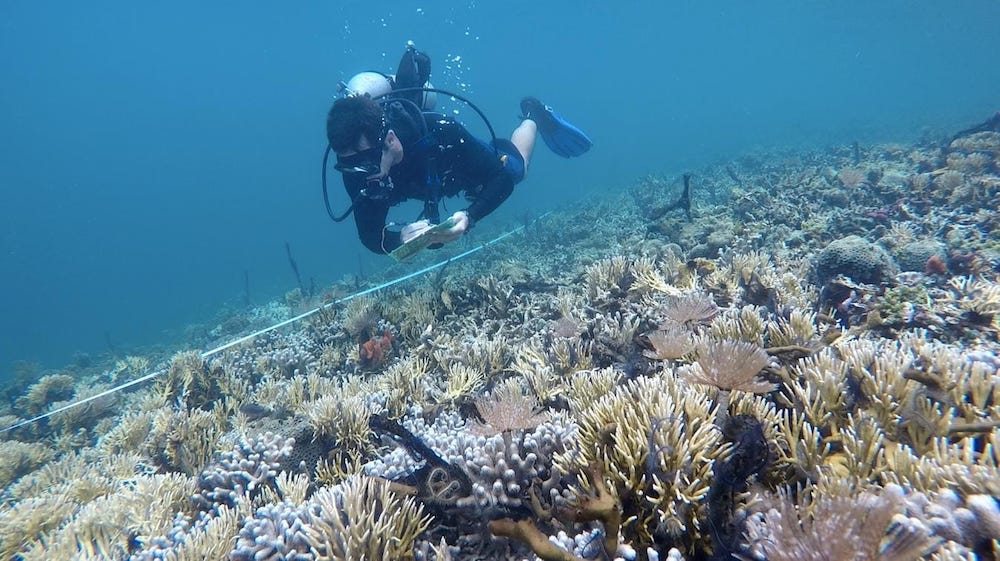Downloads
Download the protocol documents, field- and laboratory sheets, and data entry spreadsheets from figshare:
| Protocol | Link |
|---|---|
| Diver Visual Survey | https://doi.org/10.25573/serc.14717796 |
Purpose
Fishes are major players in most marine ecosystems. In clear water (>4 m visibility), MarineGEO uses the protocol of the Reef Life Survey (RLS) for quantifying the diversity, abundance, and size distributions of fishes, as well as large mobile macroinvertebrates. We also use use a variant of the RLS photoquadrat protocol for quantifying sessile benthic communities. Reef Life Survey applies globally standardized visual census methods developed over 30 years of shallow reef biodiversity research. These methods are applied by all RLS divers around the world – on coral and rocky reefs – and thus facilitate direct comparisons among sites surveyed using RLS protocols. Note that RLS currently requires that data collectors using these protocols be trained by approved RLS trainers in order to contribute data to the RLS database.

Selected literature
Duffy, J. E., J. S. Lefcheck, R. D. Stuart-Smith, S. A. Navarrete, and G. J. Edgar. 2016. Biodiversity enhances reef fish biomass and resistance to climate change. Proceedings of the National Academy of Sciences 113:6230–6235.
Edgar, G., and R. Stuart-Smith. 2009. Ecological effects of marine protected areas on rocky reef communities- a continental-scale analysis. Marine Ecology Progress Series 388:51–62.
Edgar, G. J., T. J. Alexander, J. S. Lefcheck, A. E. Bates, S. J. Kininmonth, R. J. Thomson, J. E. Duffy, M. J. Costello, and R. D. Stuart-Smith. 2017. Abundance and local-scale processes contribute to multi-phyla gradients in global marine diversity. Science Advances 3:e1700419.
Edgar, G. J., and R. D. Stuart-Smith. 2014. Systematic global assessment of reef fish communities by the Reef Life Survey program. Scientific Data 1:140007.
Edgar, G. J., R. D. Stuart-Smith, T. J. Willis, S. Kininmonth, S. C. Baker, S. Banks, N. S. Barrett, M. A. Becerro, A. T. F. Bernard, J. Berkhout, C. D. Buxton, S. J. Campbell, A. T. Cooper, M. Davey, S. C. Edgar, G. Försterra, D. E. Galván, A. J. Irigoyen, D. J. Kushner, R. Moura, P. E. Parnell, N. T. SHEARS, G. Soler, E. M. A. Strain, and R. J. Thomson. 2014. Global conservation outcomes depend on marine protected areas with five key features. Nature 506:216–220.
Stuart-Smith, R. D., A. E. Bates, J. S. Lefcheck, J. E. Duffy, S. C. Baker, R. J. Thomson, J. F. Stuart-Smith, N. A. Hill, S. J. Kininmonth, L. Airoldi, M. A. Becerro, S. J. Campbell, T. P. Dawson, S. A. Navarrete, G. A. Soler, E. M. A. Strain, T. J. Willis, and G. J. Edgar. 2013. Integrating abundance and functional traits reveals new global hotspots of fish diversity. Nature 501:539–542.
Stuart-Smith, R. D., G. J. Edgar, and A. E. Bates. 2017. Thermal limits to the geographic distributions of shallow-water marine species. Nature Ecology & Evolution 1:1846–1852. Nature 501:539–542.